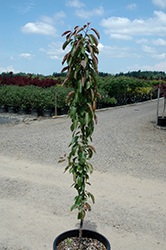Fri & Sat 8am - 8pm
Sun 8am - 7pm
Anytown, USA 12345
fax: 261.787.0463
e-mail: info@successgc.com


Plant Finder

Height: 8 feet
Spread: 24 inches
Sunlight:
![]()
Hardiness Zone: 4a
Other Names: Roseybloom, Crabapple
Group/Class: Colonnade Series
Description:
A distinctively narrow accent tree with showy deep pink flowers in spring emerging from red buds, and volumes of small, dark red fruit in late summer that is great for preserves; needs well-drained soil and full sun, excellent for smaller landscapes
Ornamental Features
Colonnade Maypole Flowering Crab is blanketed in stunning clusters of fragrant pink flowers along the branches in mid spring, which emerge from distinctive red flower buds before the leaves. The fruits are showy dark red apples carried in abundance from late summer to early fall. The fruit can be messy if allowed to drop on the lawn or walkways, and may require occasional clean-up. It has dark green deciduous foliage which emerges red in spring. The pointy leaves turn yellow in fall.
This plant is primarily grown as an ornamental, but it's also valued for its edible qualities. The small round tart apples are most often used in the following ways:
- Preserves
Landscape Attributes
Colonnade Maypole Flowering Crab is a dense multi-stemmed deciduous shrub with a narrowly upright and columnar growth habit. Its average texture blends into the landscape, but can be balanced by one or two finer or coarser trees or shrubs for an effective composition.
This shrub will require occasional maintenance and upkeep, and is best pruned in late winter once the threat of extreme cold has passed. It has no significant negative characteristics.
Colonnade Maypole Flowering Crab is recommended for the following landscape applications;
- Accent
- Vertical Accent
Planting & Growing
Colonnade Maypole Flowering Crab will grow to be about 8 feet tall at maturity, with a spread of 24 inches. It has a low canopy with a typical clearance of 2 feet from the ground, and is suitable for planting under power lines. It grows at a medium rate, and under ideal conditions can be expected to live for 50 years or more. This variety requires a different selection of the same species growing nearby in order to set fruit.
This shrub should only be grown in full sunlight. It prefers to grow in average to moist conditions, and shouldn't be allowed to dry out. It is not particular as to soil type or pH. It is highly tolerant of urban pollution and will even thrive in inner city environments. This particular variety is an interspecific hybrid.
